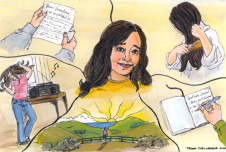“James” was an anomaly at the middle school where I worked as a psychologist. Most of the students came from upper-middle class backgrounds. James lived in a shelter with his mother, where nutritious meals and restful sleep were scarce. Every morning German cars lined the front of the school as parents dropped off their children; James commuted one-and-a-half hours by bus.
Winter approached, yet James still wore t-shirts, prompting his teacher, “Mrs. Riebe,” to give him a sport jacket she had picked up from her church. It was a kind gesture, but a sixth grader with a sport jacket in a public school meant one thing to me: a bully target. When I found James, he wasn’t embarrassed by wearing a jacket several sizes too big; instead, he was smiling from ear to ear. I tried to talk but he kept cutting me off. “Dr. Froh, check out this cool jacket Mrs. Riebe gave me,” he said. “I love it. I can’t stop thanking her.” James stood in the hallway wearing an oversized sport jacket, tired, hungry—and expressing gratitude. Many other students wore the latest trends, slept in comfortable beds, were well-fed, and yet craved more.
This was a defining moment for me. I started to imagine how our school’s climate might change if more of our students could learn to express gratitude for all they had been given in their lives. By helping them appreciate the daily gifts bestowed upon them—friends who offered emotional support, teachers who gave up their lunch period to provide extra help, staff who cleaned their hallways and lunch tables—I thought we might strengthen their feelings of closeness and commitment to each other, their teachers, and their entire school.
Research by Robert Emmons and Michael McCullough, among others, had already found that keeping a “gratitude journal,” in which people count their blessings, provides them with mental and physical health benefits. Yet no one had investigated the effects of gratitude in youth. Emmons and I, along with our colleague William Sefick, decided to be pioneers.
In our study, we followed 221 middle school students for five weeks. We randomly assigned 11 classrooms to one of three conditions: gratitude, hassles, and a control group. Students in the gratitude condition were asked to record up to five things they were grateful for since the previous day. Students in the hassles condition were given similar directions, except to focus on irritants. Before this exercise, all of these students, along with students in a control group, completed questionnaires measuring their mental and physical health, and their attitudes and behavior toward others. They filled out the same questionnaires immediately after the two-week intervention, and then again three weeks later.
Students in the gratitude condition found they had many blessings to count. While some of these were a bit idiosyncratic (e.g., being thankful for Star Wars books), the common denominator was acknowledging a gift given by a benefactor. Their journals included entries such as: “I am grateful that my mom didn’t go crazy when I accidentally broke a patio table,” “My coach helped me out at baseball practice,” and “My grandma is in good heath, my family is still together, my family still loves each other, my brothers are healthy, and we have fun everyday.”
But we still had to answer the million-dollar question: For our school and our students, what were the greater benefits of giving thanks?
The results were clear: Higher levels of optimism, increased life satisfaction, and decreased negative feelings were all associated with students’ expressions of gratitude. By the follow-up three weeks later, students who had been instructed to count their blessings showed more gratitude toward people who had helped them, which led to more gratitude in general.
Expressing gratitude was not only associated with appreciating close relationships; it was also related to feeling better about life and school. Indeed, compared with students in the hassles and control groups, students who counted blessings reported greater satisfaction with school both immediately after the two-week exercise and at the three-week follow-up. They made statements such as: “I go to a great school,” “I am grateful for my education,” and “I am thankful for my academics and for making the National Junior Honor Society.”
These encouraging results inspired me to take this exercise one step further: I shared it with our entire middle school. All of our roughly 1,000 students were given the same instructions as the gratitude condition from our study.
We didn’t keep track of changes on a school-wide level, but the results were definitely visible in my homeroom class. Several students said they recognized that “life could be so much worse.” One student, who was from a wealthy family, stated, “I realized how good I really have it. Some kids have nothing. I just never thought about it before.”
I don’t mean to suggest that counting their blessings for two weeks will cause adolescents to stock up on thank you cards; I think becoming a grateful person takes a prolonged, consistent effort. But the time to start practicing gratitude is when you’re young, and I think schools can play a vital role—especially since our intervention only took a few minutes a day. As our results suggest, gratitude serves the school’s educational mission while also tending to students’ social and emotional needs. By helping to teach it, we might make kids more receptive to everything else they can learn from their teachers, parents, and friends.





Comments
I liked this article very much. I wrote a book with my colleague, Doro Marden - Raise Happy Children- in which we mention the value of thankfulness in our last chapter on Happiness. We suggested asking children to think of three things they are grateful for as part of their bedtime ritual. I think it’s a wonderful idea to introduce this idea in schools.
Glenda Weil | 4:19 pm, February 25, 2012 | Link